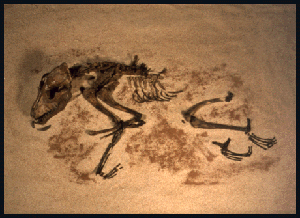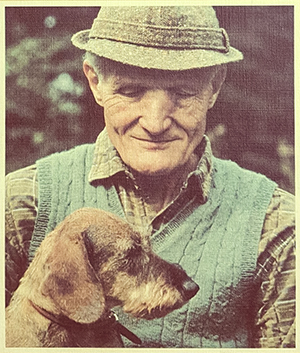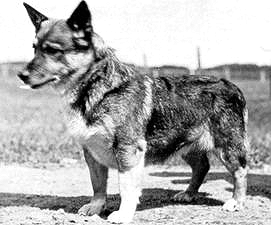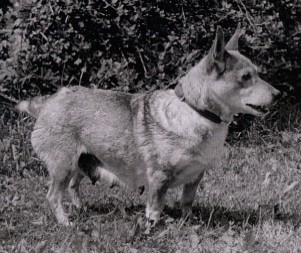History of the Swedish Vallhund
Out of the Viking Age
From archaeological remains, we know that the dogs of the Norse people, dating back thousands of years were a spitz type canine. They were produced from the interbreeding of the native arctic wolf with the domestic dogs from the south. These dogs were used for hunting, chasing in the hunt, herding, herd protection and companionship. Several breeds recognised today pre-date or come out of the Viking age. The Swedish Vallhund is a very ancient national dog breed of Sweden and dates back to the 8th/9th century. They were the alert, eager, and brave dogs used to herd cows. They were likely also known as Vikingarnas dog. Being a small, low to the ground dog the characteristic trait of herding was achieved by rounding and nipping at the hocks cattle. This behaviour has been utilised and preserved down through the ages. These dogs with their bright, jaunty temperament made them suitable as a working dog, watchdogs and companions.
The Decline & Rescue
The advertisement had been placed by Count Björn von Rosen. Björn, a dog enthusiast and coincidentally a terrier judge, was looking for the little Svensk Vallhund. Having already been involved in the saving of several other Swedish breeds Bjorn had set his sights on the farm dogs he remembered from his boyhood days. As a child, he had spent summers with a friend on their farm in Västergötland. The dogs were a very familiar sight. They were oft observed eagerly running ahead of the horse teams, following the farmers to market and noted at stock sales.Vara is a township in the south west of Sweden. It was here in the 1920’s that Karl Gustav Zetterstén a school teacher, and well known Scottish Terrier breeder, took up a position at the local high school. Karl had noticed and was interested in the attractive, usually bobtailed little Svensk Vallhund at horse sales and the surrounding farmland district. These dogs were the invaluable working farm dogs that rounded cattle and cleared the farmyard of vermin. These jaunty dogs had been relatively common right up until WWI. But over the next decade or two, their numbers had rapidly declined and had all but disappeared. Fate though was about to intervene. Karl’s attention was caught one spring day in 1942 by an advert placed in the Skaraborg Newspaper.
So united by an advert, and a passion for dogs Björn Von Rosen and Karl Gustav Zetterstén were about to embark upon a rescue. While the world was in the grips of WWII, a search for what surviving dogs remained began in earnest. They toured around the Vara plains, up and down country lanes on bicycle scouring for surviving dogs.
They found many crossbreeds and dogs with obvious Svensk Vallhund in their lineage. But the hope of finding unmixed dogs was waning. Of historical interest, pertaining to the possible relationship with corgis, Count von Rosen noted that with their extensive search there were no known Pembroke Welsh Corgis in the Vara region.
Success
The summer weeks passed in this endeavour, and then suddenly there she was. They had happened upon Topsy and she was found on Andersson’s farm. Topsy was described as a perfect, grey, bobtailed female. Later discovered, a male called Mopsen. While healthy, Mopsen only had one testicle. Not an ideal situation. But without a lot of choices and considering cryptorchid was not a disqualifying aspect at the time, Mopsen was to become the first recognised stud of the breed. And so with two more bitches, Lessi, and Vivi, the men started upon a breeding programme. It is believed that Mopsen sired a dog pup, Jerry265OTT, out of Lessi. Mopsen also sired a bitch pup, Tessan3999VV, out of Vivi. And Mopsen may have sired Borgalls Mopsan7871VV out of Topsy. Although this is uncertain as at the time she was found Topsy was an older bitch of 12 years. Also in the uncertainty is the belief that Vivi may be a daughter or granddaughter of Topsy, as both Vivi and Topsy came from the same owner, farmer Herman Johansson.
The Swedish Kennel Club
Björn Von Rosen recognised early that Topsy was the best specimen of them all and began to write the first breed standard based on her qualities. This standard, along with photos of the other dogs was sent to the Swedish Kennel club. Credit must also be paid to the Swedish Kennel Club, they too were very keen to see the breed saved and recognised. So by that autumn a total of six initial dogs, along with their owners, travelled to a Göteborg dog show where the dogs were assessed by three judges. The first being Count von Rosen, also Colonel Bertil Burén, and Baron Carl Leuhusen.
The gentlemen were of one mind that Topsy was indeed the ideal specimen. She was regarded as having a beautiful body, a strong head and perfect quality of hair [fur] and the correct grey colour. All the initial dogs were grey. Although Karl-Gustaf Zetterstén managed to have the acceptable colours include brown, yellow and red-brown in the 1950’s. There was much determination to ensure that in ongoing breeding the dogs should still “look like grandfathers dog” and retain the ability to herd.
The men also believed that a correct Swedish Vallhund’s coat was maintained as vital. The breed should always have a half-long coat with undercoat. It shouldn’t be soft or open. After a year of exhibition shows the kennel club recognised the breed in 1943.
Björn von Rosen had been writing articles about the breed, published in Svenska Dagbladet, a major newspaper. This prompted a lot of public interest and demand. Karl Gustav Zetterstén, still breeding terriers and initially with no intention to breed Swedish Vallhund established the kennel Borghälla. This was prompted by the Swedish Kennel club continually referring puppy seekers to him. Zettersén felt a duty to care for and continue the breed, Zettersén continued with the bicycling and the search for more dogs and managed to find a lovely bitch, Tyra. Tyra sported a white chest and had a good length of leg. And her breeding was known back three generations (of dams). And her father was known as Nicke. Tyra was mated to Pelle, a Mopsen son out of Tessan. One very beautiful boy, Borghällas Ajo from the litter of five that resulted went on to become a very notable stud with his very straight forelegs, close-fitting, short & hard grey coat. Zettersén also bred the ‘Borghällas Delila’, the very first Swedish Vallhund Champion.
Then in 1964, the Swedish Breed standard was revised and the name Västgötaspets was officially adopted acknowledging the region of Västergotland were the rescue was initiated. Translated Västgötaspets means, ‘Spitz of the West Goths’.
Content written by Peta Dowle
References:
Serpell J., The Domestic Dog, Its Evolution. Behaviour and Interactions with People.Cambridge: Cambridge Univ. Press. 1995.
Hubbard Clifford. L B., Dogs in Britain; a Description of All Native Breeds and Most Foreign Breeds in Britain. London, MacMillan. 1948
Swedish Kennel Clubs Magazines Special number:”Hundsport Special” 5/86
Gascoigne.Nicky., The Swedish Vallhund. Dalsetter Designs. Wakefield. UK. 1989
Bayliss. J., A Study of the Swedish Vallhund (Västgötaspets) A Pictorial History – Owners’ Hand Book. Eng. 2007.





